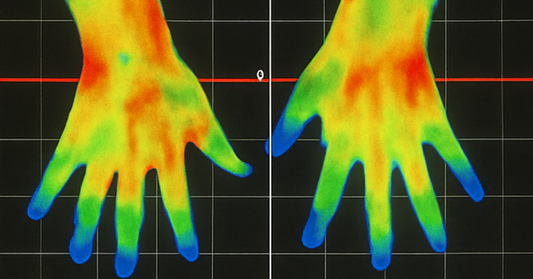
Where Entanglement Meets Geometry: Exploring the Unified Physics of ARK Technology
This article explores the fascinating physics behind quantum entanglement through the lens of the unified geometric theory developed by Nassim Haramein. At the heart of this framework is a profound insight: the quantum electromagnetic vacuum itself is inherently entangled [1], meaning that spatially separated regions of space remain strongly correlated through an underlying network of quantum connections. Because ARK Technology is designed to couple with and resonate within this quantum vacuum field, ARK products can access this intrinsic entanglement network—providing the physical basis for concepts like Entangled Pairs and establishing a direct link between cutting-edge unified physics and practical applications in coherence and connection.

Figure 1. “Quantum fields in vacuum states carry an infinite amount of quantum entanglement.” — Masahiro Hotta
1. Quantum Entanglement: The Core of Non-Local Interconnection
Quantum entanglement is a foundational concept in physics, describing how two or more particles can become linked in such a way that their physical properties are perfectly correlated, regardless of the distance separating them.
1.1 Quantum Entanglement: The Core of Non-Local Interconnection
Quantum entanglement is a foundational concept in physics, describing how two or more particles can become linked in such a way that their physical properties are perfectly correlated, regardless of the distance separating them.
Let's explore some of the key features of quantum entanglement and what makes it a "non-classical" property (as in "classical" physics, that describes matter as solid, physically distinct objects that follow strict cause-and-effect dynamics).
Non-Separability: In the conventional quantum formalism, entangled subsystems cannot be described independently—they form a single, unified quantum state. The mathematical description requires a joint wave function or density matrix that cannot be factored into separate states for each particle. This non-separability means that measuring one particle instantaneously affects the quantum description of the entire system, reflecting the fundamental interconnectedness of entangled entities even when spatially separated.
Not Mysticism; Unified Physics: The seeming instantaneous connection between particles that keeps them strongly correlated—called Einstein-Podolsky-Rosen pairs (EPR pairs)—regardless of physical separation, may seem mysterious but finds elegant explanation within Unified Physics. Remarkably, both key pieces of this puzzle emerged in 1935. In their paper "The Particle Problem in the General Theory of Relativity," Einstein and Rosen proposed that elementary particles could be understood as geometric structures in spacetime—specifically, as bridges or wormholes connecting different regions of space. Then, Einstein, Podolsky, and Rosen published their now-famous paper demonstrating that quantum mechanics predicts peculiar correlations between spatially separated particles (EPR correlations of EPR pairs), correlations that seemed to challenge locality itself.
In the unified framework, these two 1935 insights converge: particles are sustained excitations of the quantum electromagnetic field, the energy of which curves spacetime into physical geometric structures—the very bridges Einstein and Rosen envisioned. These structures are called Einstein-Rosen bridges (ER), and they provide the physical mechanism underlying the EPR correlations between entangled particles, such that ER = EPR [2]. Far from mysticism, entanglement reflects the actual geometric connectivity of spacetime at the quantum scale.

Figure 2. ER = EPR. Einstein and Rosen (1935) showed that distant black holes can be connected by a wormhole. Physicists suspect that wormhole connections and quantum entanglement are fundamentally the same, differing only in scale.
Technological Foundation: Entanglement is not just theory; it's the critical resource enabling quantum computing (using entangled qubits) and ultra-secure quantum communication (via quantum teleportation). It fundamentally challenges classical concepts of separability and independent reality. With the ability to transfer and process quantum information, large-scale quantum networks will enable a suite of fundamentally new applications, from quantum communications to distributed sensing, metrology, and computing [3].

Figure 3. State-of-the-art experiments showing the potential of color centers in diamond as quantum network nodes. Schematic of a three-node quantum network based on nitrogen-vacancy (NV) centers in diamond, linked with optical fibers. One of the network nodes features a C nuclear spin that is used as a memory qubit to store (part of) an entangled state and free up the communication qubit, while subsequent entanglement is created using this communication qubit a second time.
While conventional quantum mechanics successfully describes entanglement's correlations and enables powerful technologies like quantum computing and secure communication, it does not explain the underlying physical mechanism that connects entangled particles across space. The unified geometric framework developed by Haramein and colleagues provides this missing piece by demonstrating that entanglement is not merely an abstract quantum correlation, but rather a manifestation of actual geometric structures in spacetime itself. This framework reveals that the quantum vacuum—far from being empty space—is a dynamic, interconnected web of Einstein-Rosen bridges arising from coherent electromagnetic fluctuations. Understanding this geometric foundation of entanglement opens the door to resonance-based technologies like ARK Technology, which are designed to couple with and harness the intrinsic connectivity of the quantum vacuum field.
2. Entanglement in the Unified Geometric Framework
The research paper by Haramein, Alirol, and Guermonprez [4] provides a breakthrough geometric interpretation of reality that expands the meaning of entanglement. Building directly on Einstein–Rosen’s geometric intuition, the authors argue that vacuum fluctuations are not a passive background but an active source of spacetime curvature, and that this curvature expresses itself as mass, as gravitational dynamics, and as the effective confinement seen at nuclear scales. In their view, the coupling between the quantum vacuum’s energy density and the Einstein field equations yields a multi-scale, self-consistent curvature that gives rise to the phenomena we currently attribute to distinct forces.
More concretely, the framework recasts mass as an emergent property of geometry—localized curvature sustained by vacuum fluctuations—while nuclear confinement is modeled as a curvature-driven containment mechanism rather than a purely gauge-theoretic interaction. Gravity, in turn, is presented as the macroscopic limit of the same fluctuation-induced curvature, unifying what are typically treated as separate domains. Perhaps most notably, the paper expands entanglement beyond Hilbert-space correlations to a fundamentally geometric notion of connectivity: coherent, scale-coupled curvature patterns that maintain informational linkage across regions of spacetime, conceptually resonant with Einstein–Rosen bridges and topological identifications. This perspective places information, energy, and geometry on the same footing and suggests that so-called “nonlocal” correlations may reflect deeper, structured adjacency in the fabric of spacetime itself. The result is a cohesive, differential-geometric synthesis that gestures toward observable consequences—such as curvature-driven confinement signatures and vacuum backreaction effects—while offering a clear, unified narrative bridging quantum and relativistic regimes.
This breakthrough result demonstrates that all fundamental forces and mass arise from the coherent interaction of the ultra-high-density quantum vacuum electromagnetic field. Haramein’s solution indicates that, at the proton’s reduced Compton wavelength, it exactly satisfies the Schwarzschild condition, which is the solution of Einstein field equations that describes a black hole/wormhole: revealing that the proton hosts an Einstein-Rosen bridge and, importantly, that all protons participate in an ER bridge network.
This result, taken together with the ER=EPR conjecture [5], points to a quantum vacuum composed of a vast network of Planck-scale micro-wormholes. Because vacuum fluctuations generate correlated spacetime curvature (mass) through coherent wormhole structures, the vacuum can be understood as a fundamentally interconnected web of microscopic ER bridges linking all points in space.
Observable particle entanglement, therefore, is not just correlated behavior; it expresses actual geometric connections—micro-wormholes—threaded through the fabric of spacetime.
In this unified view, the instantaneous correlations of entanglement follow from spacetime—the universe’s most fundamental fabric—being inherently and non-locally connected. ARK Technology is engineered to harness this inherent non-local interconnectivity by inducing coherence in the quantum vacuum and increasing resonance coupling with the entanglement network.
3. Macroscopic Entanglement in Practice: Crystals and Harmonic Resonators
Quantum nonlocality is not confined to single photons or atoms. Over the last decade, researchers have engineered entanglement in genuinely macroscopic, mechanical degrees of freedom, using two complementary platforms: (i) collective phonon modes in diamond crystals and (ii) chip-integrated mechanical drumhead resonators. Both approaches hinge on mechano-resonance—the fact that quantized vibrations can be prepared, coupled, and read out with field modes (optical or microwave) while preserving nonclassical correlations.
3.1 Entangled Diamonds: Phonons in a Crystal Lattice (Room Temperature)
In a landmark experiment, two millimetre-scale diamond crystals, separated by centimetres, were driven with ultrafast laser pulses so that a single vibrational quantum (optical phonon) was created in a spatially delocalized superposition across both crystals. A subsequent “read” pulse converted the phonon back to light, allowing nonclassical correlations to be verified between the distant crystals. Crucially, this demonstration occurred at room temperature, showing that the ordered, high-stiffness lattice of diamond can host entanglement in collective motion despite environmental noise. In short: the crystal’s intrinsic coherence and mechanical resonance enabled macroscopic entanglement to “peek through the classical keyhole" [6].
Why it matters. The diamond result establishes that crystalline order + ultrafast phonon mechanics can protect and reveal entanglement at ambient conditions. This directly supports the view that mechanical resonance in high-quality crystals is a powerful, scalable route for realizing macroscopic quantum links.

Figure 4: Two millimetre-scale diamond crystals are separated by centimetres. An ultrafast laser pulse creates a single optical phonon in a spatially delocalized superposition across both crystals, which is later converted back to light by a readout pulse. Nonclassical correlations observed at room temperature demonstrate that diamond’s lattice coherence can support macroscopic entanglement.
3.2 Deterministic Entanglement of Massive Mechanical Oscillators
A complementary line of work has directly observed deterministic entanglement between two spatially separated mechanical drumheads (membrane resonators) integrated with a superconducting microwave circuit. Using pulsed electromechanics (microwave fields that couple to the motion), the team engineered two-mode squeezing between the resonators and measured the joint mechanical state with sufficient precision to certify entanglement. This experiment pushes nonclassical correlations to larger masses and longer lifetimes by leveraging high-Q mechanical resonance and quantum-limited readout [7].
Why it matters. These results show that mechanical resonators—not just photons or spins—can be entangled on demand, providing a robust platform to explore the quantum-to-classical boundary and to build hybrid quantum networks where mechanical motion serves as a universal bus between optical, microwave, and spin systems.
3.3 Takeaways for a Unified, Resonance-First Perspective
-
Mechano-resonance is the common denominator. In both crystals and drumheads, quantized vibration is the carrier of nonlocal correlations, controllably interfaced with electromagnetic fields for state preparation and readout.
-
Crystalline order enhances coherence. Diamond’s rigid lattice and high Debye temperature support collective phonon modes that can be entangled and probed even at ambient temperature, highlighting the special role of crystals in macroscopic quantum effects.
-
Scalability via hybrid coupling. Mechanical modes couple naturally to light (optomechanics) and microwaves (electromechanics), providing field-tunable pathways to distribute entanglement across scale and platform. This demonstrates how utilization of similar resonance-based technologies, like the Harmonic Flux Resonator (HFR) can bridge quantum and macroscopic regimes, enabling coherence-enhancing technologies.
Implication. If macroscopic entanglement is most readily stabilized where geometry + resonance are intentionally engineered (as in crystals and high-Q mechanics), then devices designed to enhance mechanical coherence and field coupling are naturally positioned to access, sustain, and route nonlocal correlations—linking laboratory demonstrations with resonance-based technologies.
4. Conceptual Link to ARK Technology and "Entangled Pairs"
ARK Technology is engineered to drive coherence, resonance, and interaction with the quantum electromagnetic vacuum.The link between the unified physics model and ARK products, specifically the idea of entangled pair products, is established as follows:
4.1 Resonating with the Coherent Vacuum
The unified physics of Haramein suggests that coherent modes of quantum fluctuation energy density of the electromagnetic vacuum is the source of all emergent physical properties. ARK Technology is designed with a specific geometry intended to create a coherent field of resonance, inducing these structured domains of quantum vacuum fluctuations and thus coupling with the energy density of the Field and its limitless quantum entanglement.
So, If the vacuum is an entangled, non-local network, as observational evidence and the geometric approach reveals, a device designed to enhance local coherence, as ARK Technology does, is harnessing the intrinsic non-locality of the quantum field and will have the same interconnectivity of entanglement that links all systems together in a dynamic spacetime geometric network.
4.2 The Analogy of Entangled Pairs
The term "entangled pair" used in the context of certain ARK products is a conceptual analogy rooted in the principle of non-separability and correlation at a distance inherent in quantum entanglement.
-
The Physics Principle: Quantum entanglement ensures that two particles are always correlated, acting as a single, shared system.
- The ARK Application: The Entangled ARK Pair facilitates a shared, coherent resonance across distance. This functionality mirrors a key property of entanglement: the two items are treated as a single, unified system that shares a coherent connection, influenced by the surrounding vacuum field.
5. ARK Technology: Empowering Your Full Potential
Where unified physics suggests that entanglement is a non-local geometric property of the vacuum that gives rise to all reality, ARK Technology aims to harness or resonate with this same fundamental property for practical applications.
Users may experience benefits such as: maintaining coherent connection with loved ones across physical distances through shared resonance with the interconnected vacuum field; enhancing personal coherence and well-being by attuning more deeply to the source field (the quantum vacuum); and facilitating structured energetic connection in environments where coherence and harmony are desired—whether in personal spaces, wellness practices, or collaborative settings.
By utilizing the powerful conceptual language and principles of quantum entanglement, ARK Technology products are designed to serve as tools for engaging with the fundamental interconnectivity that underlies physical reality.
References
-
Brown W.D., “Quantum Energy Teleportation Protocol - The International Space Federation (ISF).” Available: https://spacefed.com/technology/quantum-energy-teleportation-protocol/
-
Brown, W.D., Traversable Wormhole Teleportation Protocol—The International Space Federation (ISF). (2023, January 4). https://spacefed.com/physics/traversable-wormhole-teleportation-protocol/
-
M. Ruf, N. H. Wan, H. Choi, D. Englund, and R. Hanson, “Quantum networks based on color centers in diamond,” J. Appl. Phys., vol. 130, no. 7, p. 070901, Aug. 2021, doi: 10.1063/5.0056534.
-
N. Haramein, O. Alirol, and C. Guermonprez, “Extending Einstein-Rosen’s Geometric Vision : Vacuum Fluctuations-Induced Curvature as the Source of Mass, Gravity and Nuclear Confinement,” Sep. 23, 2025, Preprints: 2025091835. doi: 10.20944/preprints202509.1835.v1.
-
Susskind, L.“Copenhagen vs Everett, Teleportation, and ER=EPR,” Fortschr. Phys., vol. 64, no. 6–7, pp. 551–564, Jun. 2016. doi: 10.1002/prop.201600036.
-
P. Ball, “Entangled diamonds vibrate together,” Nature, Dec. 2011, doi: 10.1038/nature.2011.9532.
-
S. Kotler et al., “Direct observation of deterministic macroscopic entanglement,” Science, vol. 372, no. 6542, pp. 622–625, May 2021, doi: 10.1126/science.abf2998.







